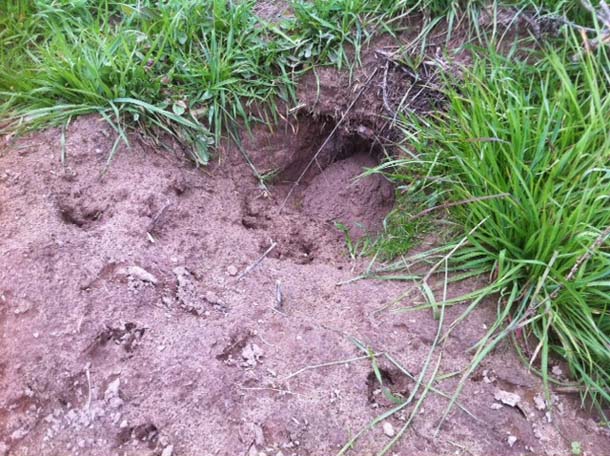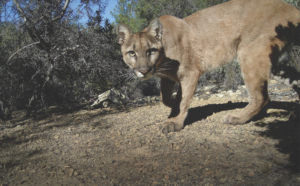In west Petaluma, a hilly, treeless plot of land will be declared the Paula Lane Nature Preserve next month because of the tenacious work of local residents who were inspired by an equally tenacious creature — the American badger.
At the forefront of the effort is Susan Kirks, who co-founded the Paula Lane Action Network (PLAN) in 2001 in order to keep the 11-acre property out of the hands of housing developers. The 10 year land battle is coming to a close, but to Kirks there’s still work to be done. At 58, Kirks, an acupuncturist by day, has made a life’s mission out of studying, protecting, and providing PR for this much maligned member of the weasel family.
“I think there is a symbolic connection to make around the tenacity that she has shown, that badgerly spirit of digging in and not being deterred,” said Brock Dolman of the Occidental Arts and Ecology Center. “She could see the value of Paula Lane, and the badger became the totem species that represented a lot of that value.”
Dolman and Kirks often exchange badger sightings since she began the BadgerMap project, a research project on badger habitats in Sonoma County.
On a recent morning, Kirks walked gingerly around the badger habitat at Paula Lane,
identifying foraging holes from dens that are nearly identical to the untrained eye, and with an ease in which most of us distinguish apples from oranges. She guessed the age of the dens to establish when the badgers were last there, then quietly retreated from the property, preferring to observe it from Paula Lane, the road running along its easternmost side.
“I’ve kept my boundaries,” she said. “The habitat is really important to understand. When I see fresh burrows, I want to stay as far away as possible.”
Just how Kirks fell in love with badgers, of all creatures, dates back to her arrival in the neighborhood 12 years ago. Having moved to west Petaluma with her two rescued horses, it wasn’t long before Kirks began to notice holes in the ground. A friend told her they were badger dens, which piqued her curiosity. She began to spend much of her time observing the land.
Kirks said her connection to the badgers at Paula Lane is healing and has reignited her childhood passion for the outdoors.
“The funny thing is, I never intended to become a naturalist that has a body of knowledge about the American badger,” Kirks said, laughing. “But the more I came to understand the species, the more I realized what a significant role it plays in ecosystems.”
Kirks feels a special connection to the Paula Lane badgers, who are naturally reclusive
except when defending their young. Being a bit people-shy herself, she prefers to keep her cap pulled over her eyes. And she often jokes about her “badgerly” spirit, which she deployed in full force in the fight for Paula Lane.
Indeed, badgers may not be the most cuddly of creatures, but Kirks believes they have been unnecessarily maligned. Sport hunting of badgers for their pelts is still allowed in California from mid-November until the end of February, even though the population of these black-and-white striped omnivores has been declining because of habitat loss stemming from development.
As Kirks explains, badgers are a critical species to their grassland habitat. Their dens, which they inhabit temporarily before moving on, create useful habitat for California tiger salamanders, red-legged frogs, and burrowing owls. Badgers also hunt voles, mice, and gophers, keeping rodent populations in check. What’s more, studies have shown that badgers leave enough small prey for raptors like the red-tailed hawk, and even engage in cooperative hunting with coyotes.
These qualities went into several reports compiled by local biologists to demonstrate their value in the face of the proposed development.
The development proposal was dropped in 2005, and PLAN orchestrated a partnership between the City of Petaluma and the Sonoma County Open Space District. Together, they agreed on purchasing the land as an open space preserve, under the condition that PLAN maintains the land.
In addition to preserving wildlife habitat, the Paula Lane Nature Preserve will feature a perimeter walking trail, a community garden, and a hands-on environmental education program, all maintained by PLAN volunteers.
Kirks is currently working on a research project that gathers information about badger habitats between south Sonoma County and the Sonoma Coast. The project, called BadgerMap, can be found online at iNaturalist, a website that compiles species sightings. Kirks hopes it will provide helpful data to researchers at the Bay Area Open Space Council for their upland habitat database.
Kirks said knowing the location of these habitats and the corridors that connect them will help protect wildlife as they migrate into new areas under climate change.
“She’s a force to be reckoned with,” said biologist Kim Fitts. “She pretty much single-handedly corralled people into doing their part, into making statements, and doing bake sales. It’s pretty amazing. Early on, I said I just don’t see it working.”
But it did work. And the badgers at Paula Lane Nature Preserve have their neighbors to thank for it.

.jpg)



